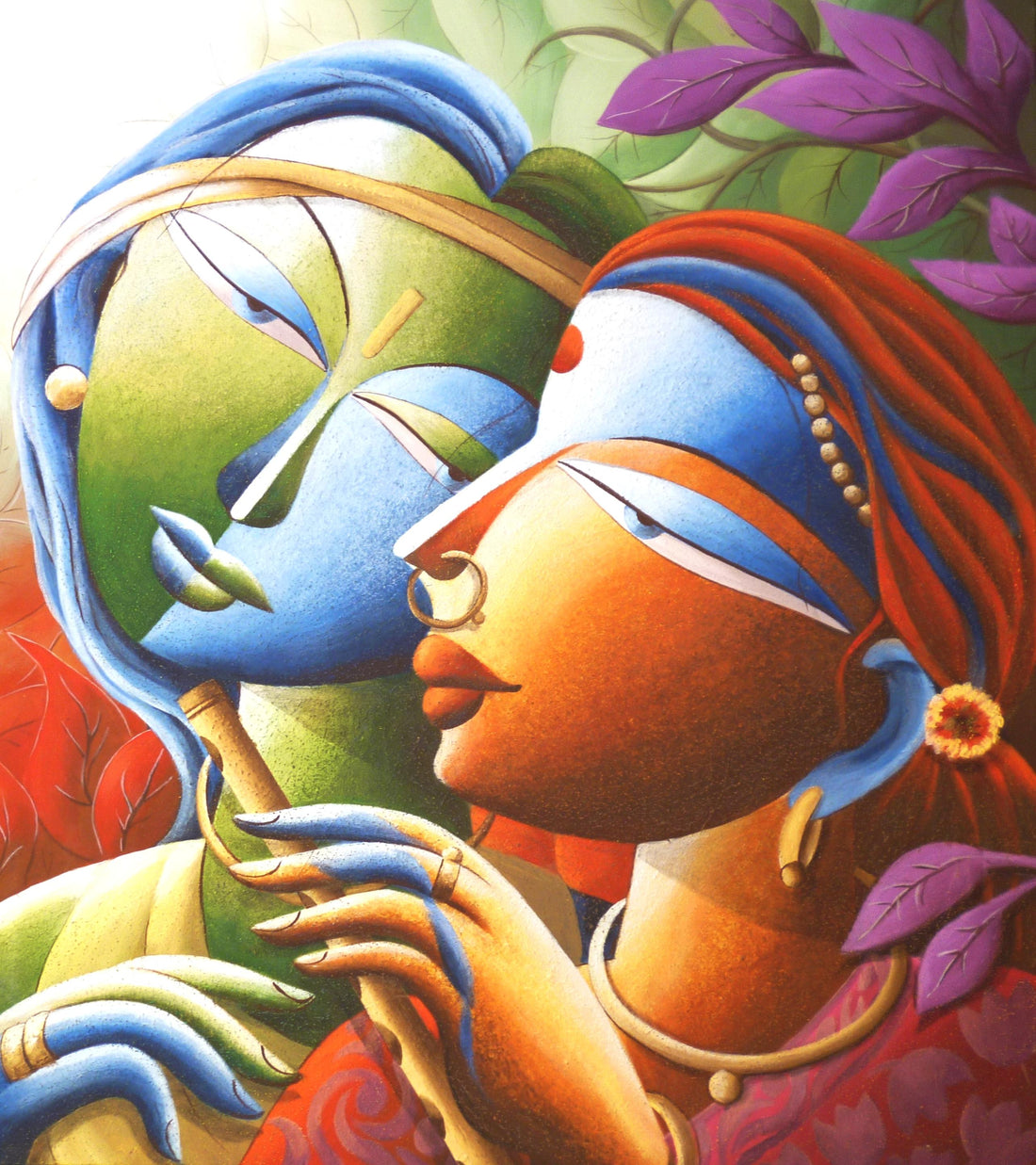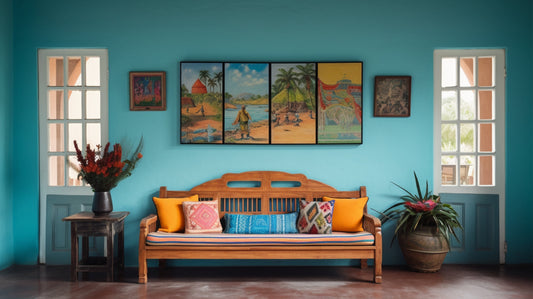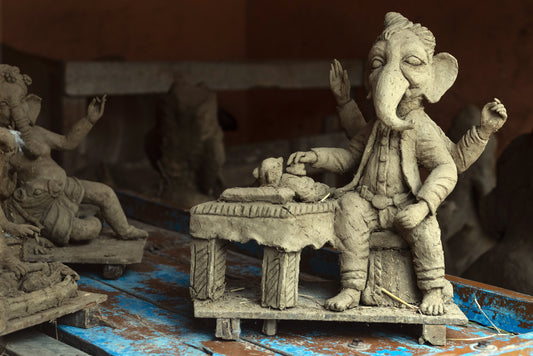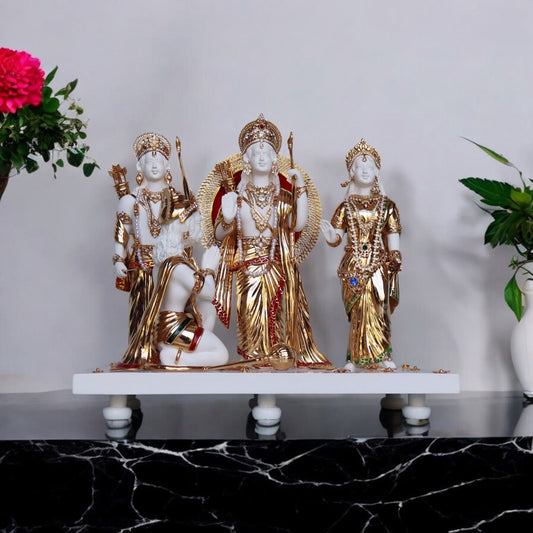Exploring The History Of Indian Painting: From Ancient To Contemporary

Let’s start with a simple question: Do you like Indian paintings? If YES, this blog is exactly for you. If not, maybe it will change your mind.
India has a unique and diverse culture that is reflected in its art, especially in the form of paintings. In this blog, we will uncover the uniqueness and impact of Indian paintings.
We will explore its journey from ancient times to the current era. We will also talk about how they reflect cultural diversity through different types of Indian paintings. Get ready to dive into a colourful and inspiring journey through the world of Indian paintings!
Directly Jump Here
- The evolution of Indian paintings over the years
- The uniqueness and impact of Indian paintings
- From wall murals to canvas: The various mediums of paintings from India
- The influence of Indian paintings in home decor
- Frequently asked questions
- Conclusion
The evolution of Indian paintings over the years
Ancient Indian paintings can be traced back to cave art and mural paintings, showcasing the rich artistic heritage of the country. We will cover each era in detail:
Ancient era of Indian paintings
During the ancient era, Indian paintings were primarily religious in nature and focused on depicting gods, goddesses, and the culture of that specific region. Artists would use natural pigments like charcoal, powdered leaves, rice flour, turmeric, and lime to create vibrant colours for their illustrations. Cave art and mural paintings played a significant role in ancient Indian painting, showcasing scenes from Hindu epics such as the Ramayana and Mahabharata.
These paintings were drawn as a means of storytelling and preserving cultural heritage. The ancient era of Indian paintings laid the foundation for future artistic styles and techniques, establishing a rich and diverse tradition that continues to inspire artists today.

Mediaeval period of Indian paintings
During the mediaeval period, Indian paintings experienced a flourishing of different regional styles. Prominent among these were Rajput and Pahari paintings, which depicted royal portraits and courtly life. The royal painting needed royal preparations as well. The painters used vibrant colours, intricate details, and gold leaf embellishments.
They captured the essence of Hindu mythology and historical events while also incorporating elements from Mughal and Persian art. The mediaeval period was a significant milestone in the evolution of Indian paintings, adding depth and complexity to the artistic landscape.

You can buy this serene artwork which can be the perfect focal point for your living room from Satguru’s online store.
The modern era of Indian paintings
The evolution of Indian paintings reflect contemporary themes and styles, showcasing a fusion of traditional and contemporary elements. Artists in this era experiment with various techniques and mediums, creating innovative and thought-provoking artwork that explores new narratives and perspectives.
The range of styles in modern art paintings is vast, spanning from abstract to realism. These paintings beautifully demonstrate the use of vibrant colours, intricate details, and unique mediums such as rice paste, cow dung, and plant sap, among others. The modern era of Indian paintings truly captures the essence of artistic expression and cultural evolution. You can check out this amazing article to get extremely detailed knowledge on not just Indian painting but Indian art in general.
The uniqueness and impact of Indian paintings
Indian paintings have been an integral part of Indian culture for over 70,000 years. Let's explore what kind of impact the paintings have had on our country:
How Indian paintings reflect cultural diversity
Indian paintings beautifully capture the cultural diversity of India through their various styles and themes. These artworks depict the rich traditions, customs, and beliefs of different regions. From religious themes to landscapes and folk art, Indian paintings showcase a wide range of subjects.
Hindu epics like the Ramayana and Mahabharata are often depicted, adding a touch of mythology and spirituality to these artworks. These scenes from the epic also teach us the value of dharma, karma, relationships, and politics.
Each Indian state has its own unique painting style, such as the vibrant and colourful Rajasthani paintings or the intricate Mysore paintings. The use of vibrant colours and intricate motifs in Indian paintings symbolises the country's rich cultural heritage.
Different types of Indian paintings
The land of India is blessed with numerous forms and types of Indian paintings. Let’s quickly go through some of the types:
- Madhubani paintings: The Madhubani paintings, sometimes also called Mithila art, come from Bihar, India's Mithila area. It's a kind of traditional folk art where the subjects are natural and mythological and are portrayed in elaborate, vibrant designs. Madhubani art is a visually arresting and culturally significant art form that is renowned for its daring use of lines and geometric patterns. You can check out this amazing Madhubani painting created by Ranjit Jha on Satguru’s online store.

- Warli paintings: In the Warli region of Maharashtra, India, tribal groups engage in the ancient art form called Warli painting. Simple forms and concentric rings are frequently used in these paintings to represent the cycles of nature, life, and societal conventions.Warli art stands out for its clarity and meaning, typically painted in white on a red or brown background..
- Gond paintings: Originating from the Gond tribal people of Central India, especially the states of Madhya Pradesh and Chhattisgarh, gond paintings are a traditional tribal art genre. These paintings, which feature scenes from mythology, animals, and the natural world, are renowned for their vivid colours and elaborate patterns. Gond painters employ tiny lines and dots to produce their unique style, which frequently depicts a close bond between people and the natural world.
- Miniature paintings: The emergence of the complex art form of miniature painting was first started in India during the middle ages. These paintings, which are frequently created on materials like paper, silk, or ivory, are distinguished by their diminutive size. Intricate brushwork and fine workmanship are common in miniature painting, which portrays a variety of themes such as historical events, religious themes, and courtly life. This art style is still highly regarded for its accuracy and visual appeal.
Other famous types include Mughal paintings, Rajput paintings, Tanjore paintings and Kalamkari paintings. If you are in search of an amazing tribal painting you will definitely fall in love with this tribal frame art depicting a hard working farmer. It is one of the best wall paintings for the living room if you are enthusiastic about tribal paintings.

From wall murals to canvas: The various mediums of paintings from India
From wall murals to canvas and beyond, Indian paintings have traversed a diverse range of mediums. Traditionally, one would find captivating Indian artwork on palace and temple walls, showcasing the rich artistic heritage of India. However, as Indian art evolved, painters began exploring other surfaces such as canvas, paper, and cloth.
Each region in India boasts its own distinctive style, characterised by unique techniques, vibrant colours, and captivating themes. From the intricate miniature paintings of Rajasthan to the bold Madhubani art of Bihar, from the rustic Warli art of Maharashtra to the opulent Tanjore paintings of Tamil Nadu, Indian paintings offer a kaleidoscope of cultural expressions.
Reflecting cultural traditions, mythological tales, and religious beliefs, these artworks are imbued with history and symbolism. With their profound impact on art and culture, Indian paintings continue to inspire artists worldwide.
The influence of Indian paintings in home decor
Indian paintings have the power to become statement pieces in home decor, effortlessly adding a touch of elegance and cultural richness to any space. Here are a few ways to use paintings as home decor:
Indian paintings as statement pieces
Indian traditional paintings, with their vibrant colours and unique artistry, become captivating centrepieces that add a touch of cultural authenticity to any space. The large size and intricate details of some Indian paintings create a visual impact that demands attention.
Whether it's Lord Krishna or Ganesh Ji paintings from Hindu mythology or landscape oil paintings like Banaras Ghat, these artworks evoke a sense of spirituality and serenity in a room. Additionally, Indian paintings can be displayed as standalone pieces or as part of a gallery wall, enhancing the aesthetics of any decor style.

Integrating Indian paintings with different decor styles
Indian paintings effortlessly blend with a variety of decor styles, including bohemian, eclectic, and traditional. This is achieved by pairing them with neutral or earthy tones, creating a harmonious balance within the space.
Another intriguing option is to mix Indian paintings with contemporary furniture and accessories, resulting in an interesting living room setting. For a multicultural aesthetic, Indian paintings can be showcased alongside other global art pieces.
Frequently asked questions
-
What is the purpose of Indian painting?
The purpose of Indian painting varies across time periods and regions. Some paintings were created for religious or spiritual reasons, while others served as a medium for storytelling or historical depiction. Additionally, Indian painting is used decoratively in textiles and pottery. -
How do Indian paintings differ from other forms of art from Asia or Europe?
Indian paintings stand apart from other forms of art in Asia or Europe due to their unique characteristics. They often depict religious, mythological, and cultural themes, incorporating vibrant colours and intricate patterns. Unlike canvas, many Indian paintings are created on cloth or paper. Moreover, these artworks hold deep symbolic and spiritual significance.
Conclusion
In conclusion, Indian paintings offer a captivating glimpse into the rich cultural heritage and artistic traditions of India. From ancient cave murals to exquisite canvas masterpieces, these artworks reflect the diversity and vibrancy of Indian culture. Whether it's using traditional mediums or embracing modern techniques, Indian artists have continuously evolved their craft over the years.
The influence of Indian paintings extends beyond the art world, as they can be used as statement pieces and enhance the aesthetics of any room. These timeless pieces of art are not only visually stunning but also hold deep cultural and historical significance. Explore the enchanting world of Indian paintings and bring a touch of India's artistic brilliance into your own space


